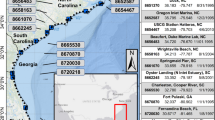Abstract
A one-dimensional transport model HEC-RAS was used to investigate the spatiotemporal dynamics of salinity in the Sebou River estuary under different hydrodynamic conditions (tides, fresh water discharge). The results show that this model well describes salt water intrusion from the sea to the Sebou River estuary, with a good agreement between computed and measured salinity values. Statistical criteria of the model output quality are obtained. The model allows the rapid assessment of salinity distribution and can help to ensure the safety of water supply and to support decision making.
Similar content being viewed by others
Change history
05 April 2018
In this article the true affiliation is Interdisciplinary Laboratory for Natural Resources and Environment, Department of Physics, Faculty of Sciences, lbn Tofail University, B.P 242, 14000 Kenitra, Morocco
05 April 2018
In this article the true affiliation is Interdisciplinary Laboratory for Natural Resources and Environment, Department of Physics, Faculty of Sciences, lbn Tofail University, B.P 242, 14000 Kenitra, Morocco
05 April 2018
In this article the true affiliation is Interdisciplinary Laboratory for Natural Resources and Environment, Department of Physics, Faculty of Sciences, lbn Tofail University, B.P 242, 14000 Kenitra, Morocco
References
L. Bennasser, M. Fekhaoui, and O. Mameli, "Assessment of the Metallic Contamination of the Low Sebou Sediments," Ann. Chimica, 90 (2000).
M. Combe, Hydrogeological Maps of the Gharb Plain in the Sebou Estuary at Low Water (1969) [in French].
G. J. Doole, T. Ramilan, and D. J. Pannell, "Framework for Evaluating Management Interventions for Water-quality Improvement across Multiple Agents," Environ. Model. Soft., 26 (2011).
M. Fekhaoui, and S. El Blidi, "Hydrology and Mareographical Dynamics of the Sebou Estuary (Gharb, Morocco)," Bull. Inst. Sci. Rabat, section "Sciences de la Vie," 25 (2003) [in French].
S. Haddout, A. Maslouhi, and M. Igouzal, "Mathematical Modeling of the Flow Regime in the Sebou River Estuary (Morocco)," in National Water Information System Congress, NWIS 2014, December 2-4, Rabat (2014).
S. Haddout, A. Maslouhi, and M. Igouzal, "Predicting of Salt Water Intrusion in the Sebou River Estuary (Morocco)," J. Appl. Water Eng. and Res., No. 1, 5 (2017).
S. Haddout, A. Maslouhi, B. Magrane, et al., "Study of Salinity Variation in the Sebou River Estuary (Morocco)," J. Desalination and Water Treatment, No. 36, 57 (2016).
S. Haddout, A. Maslouhi, B. Magrane, et al., "Analytical and Numerical Study of the Salinity Intrusion in the Sebou River Estuary (Morocco)—Effect of the "Super Blood Moon" (Total Lunar Eclipse) of 2015," Hydrology and Earth Syst. Sci., No. 9 (2016).
HEC-RAS, US Army Corps of Engineers, Hydrologie Engineering Centre. River Analysis System, Version 4 (2010).
M. Igouzal and A. Maslouhi, "Elaboration of Management Tool of a Reservoir Dam on the Sebou River (Morocco) Using an Implicit Hydraulic Model," J. Hydraulic Res., No. 2, 43 (2005).
M. Igouzal, J. M. Mouchel, K. Tamoh, et al., "Modelling the Hydraulic Regime and the Water Quality of Sebou River (Morocco): First Results," IAHS PUBLICATION, 299 (2005).
Z. G. Ji, Hydrodynamics and Water Quality: Modeling Rivers, Lakes, and Estuaries (John Wiley & Sons, Hoboken, NJ, 2008).
S. M. Kashefipour and R. A. Falconer, "A Longitudinal Dispersion Coefficient in Natural Channels," Water Res. (2002).
D. N. Moriasi, J. G. Arnold, M. W. Van Liew, et al., "Model Evaluation Guidelines for Systematic Quantification of Accuracy in Watershed Simulations," Trans. Asabe, No. 3, 50 (2007).
M. D. Nazim uddin, A. Haque, and M. D. Salequzzaman, "A bio-physical Relationship: Biodiversity with Salinity," J. Subtrop. Agric. Res. Dev., No. 3, 8 (2010).
L. Nylen and E. Ramel, The Effects of Inlet Sedimentation on Water Exchange in Maha Oya Estuary (Sri Lanka, 2012).
G. M. E. Perillo, Geomorphology and Sedimentology of Estuaries. Developments in Sedimentology 53 (Elsevier Science, Amsterdam, 1995).
D. W. Pritchard, "What is an Estuary: Physical Viewpoint," Estuaries, 83 (1967).
H. H. G. Savenije, Salinity and Tides in Alluvial Estuaries (Elsevier, Amsterdam, 2005).
F. Toublanc, I. Brenon, T. Coulombier, et al., "Salinity and Suspended Sediment Dynamics in Response to Forcing Changes in a Small Macrotidal Estuary (Charente, France)," in Proceedings of the 7th Int. Coastal Dynamics (2013).
Author information
Authors and Affiliations
Corresponding author
Additional information
Original Russian Text © S. Haddout, M. Igouzal, A. Maslouhi, 2017, published in Meteorologiya i Gidrologiya, 2017, No. 12, pp. 83-94.
About this article
Cite this article
Haddout, S., Igouzal, M. & Maslouhi, A. Modeling the effect of salt water intrusion in the Sebou River estuary (Morocco). Russ. Meteorol. Hydrol. 42, 803–811 (2017). https://doi.org/10.3103/S1068373917120081
Received:
Accepted:
Published:
Issue Date:
DOI: https://doi.org/10.3103/S1068373917120081




